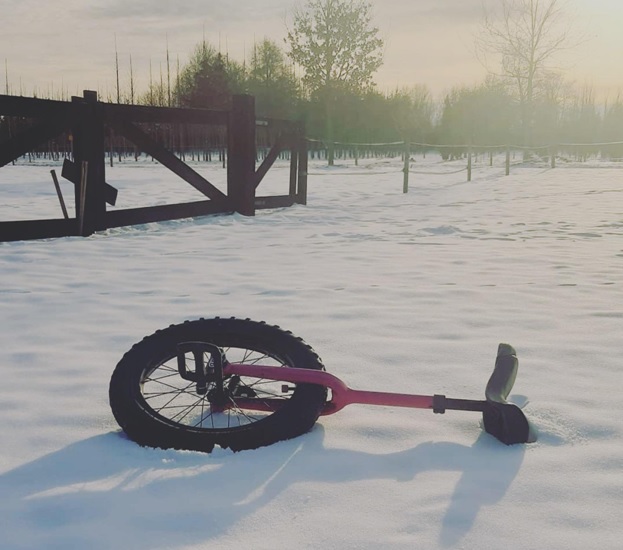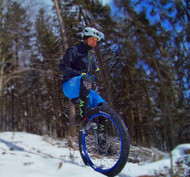Winter Unicycling: A Guide
11/19/24
Winter will be upon us in a few short weeks. For you serious trail riders, this is not the end of the season, rather an extension of it. Perhaps some of you reading this actually prefer the colder months of the year.
After all, trails get way less pressure once the summer crowds disperse. And on top of that, there’s just something magical about the winter woods, and the utter silence and stillness they carry, from December through, say, February.
Yet riding safely in the winter months is not without its own considerations. With that said, lean on our experience. Here’s how to get ready for some winter trail riding with your favorite unicycle.
Dress in Layers
This is the key to staying warm and preventing heat loss that will exhaust you (and which can put you at risk of developing frostbite).
Keeping warm has more to do with layering that offers flexibility than it has to do with wearing one big, thick layer.
Start with a light baselayer. Performance fabrics are acceptable, but merino wool is a great option too as it is light, soft, and will keep you warm, even when it’s wet.
Your mid-layer will offer most of the insulation you need to keep warm when it’s freezing. Again, performance synthetics are suitable, as is wool. Avoid cotton.
Your outer shell should be windproof and waterproof, which will help you keep warm, as, even if there is no ambient wind, riding will produce its own wind.
One note on wool vs. down. Wool, while it can keep you warm even when it gets wet, is heavy and difficult to pack. Down, on the other hand, is light, packs to virtually nothing, and offers similar thermal characteristics to wool.
This makes down perfect for riding as you can shed the down layer and pack it away when you get overheated - you just need to make doubly sure that you never let it get wet.
Special Note on Running Tubeless
If you run a tubeless rig, you should be using a tubeless sealant that’s cold weather friendly. Some sealants become too viscous in the cold and will not work if you ever have a problem with your tire. Whichever tubeless sealant you use, make sure it’s rated to the temperatures you expect to experience. In fact, go with one that’s rated a bit colder, just to play it on the safe side.

Consider a Fat Tire or a Studded Tire
Narrow street tires might be good for a smooth ride and speed on paved surfaces, but they are abysmal on a trail even before there’s snow and ice. Add these two things into the equation and you have a disastrous mix.
Fat tires are a better choice, as they offer far better traction, not only on sand, dirt, and rock faces, but also when there’s snow and ice.
A better option, if you know you’ll be riding on snow or ice, is to get a studded tire. There are tires you can get with preset studs, or, if you have the patience, you can stud your own. If you do put out the money for a studded tire, get one that you can re-stud, and read up on the process.
Studded tires perform better on ice and snow because they offer better traction - and don’t worry about wearing them out. Quality studded tires last through 3 to 5 years of heavy use, if not more, and you’re supposed to ride them hard on pavement to break them in. In fact, it takes about 100 miles of riding on pavement before you can consider them broken in. They last a long time, too; quality studs are made of zinc carbide and even the softer, more affordable aluminum studs have a lot of life in them.
So get a set and ride them on the street for a bit before you take them on the trail this winter.
Setting Tire Pressure
Just as important as your choice of tire is how you set the tire pressure. A thinner tire with properly set (lower pressure) will perform better on snow than a fatter tire that’s too hard (overly inflated). There is some wiggle room, but that’s just how it goes.
Here’s the thing; there are no hard and fast rules for setting tire pressure on snow (or ice). This is going to take some trial and error.
For higher pressure tires, lower the pressure by 1 to 2 PSI and ride a bit and see how it feels; for larger, lower pressure tires, lower the pressure by as much as 10 PSI and give it a go.
You’ll need to ride to see how it feels. If you’re digging into the snow and losing traction, you’re running too much pressure, period. Let some air out and try again. Go in small increments, though, like a half-PSI at a time, because you don’t want to overshoot the sweet spot.
Gear: The Extras

Now let’s talk about some other things you’ll want to make sure you have in your winter pack. Truthfully, most of what you’ll want to carry will be shared with your summer forays; however, you’ll also want to make sure you have:
- Spare socks and gloves: In the winter, snow and ice that melts on you will soak you. That presents a dangerous risk of hypothermia and frostbite, to which your extremities are most susceptible. Therefore you should never leave home without at least one spare pair each of gloves and socks.
- An emergency blanket: If you ever are exerting yourself hard in the cold and stop suddenly, your body temperature could plummet dangerously. An emergency blanket can help prevent this, and importantly, will pack down to about the size of a deck of cards.
- An emergency whistle: You’ll also want to have an emergency whistle with you, as a whistle can be used for signaling if you are ever fatigued and need help.
- Plenty of water: Believe it or not, in many areas of the country, winter is actually drier than summer, and that means you can easily get dehydrated much more quickly than you might think, despite the commensurately lower temperatures. It’s still critical to remain hydrated in the cold, so carry along as much water as you would in the summer and meter your intake.
Wear Appropriate Safety Gear: That’s a Helmet, Knee, Elbow and Wrist Pads
Lastly, you’ll need to wear the right safety gear, including a helmet, knee, elbow and wrist pads. The snow might look soft but it can also obscure much more dangerous obstacles, and ice under the surface can be dangerous too. Wearing a helmet and pads will help keep you safe when you experience those unpleasant unplanned dismounts.
Winter Unicycle Gear
Whether you’re here for unicycle tools, spare parts, trail accessories or safety gear like knee, elbow and wrist pads, we have you covered. Check out our online collection and get in touch with us before you buy. Otherwise, be safe out there this winter!

